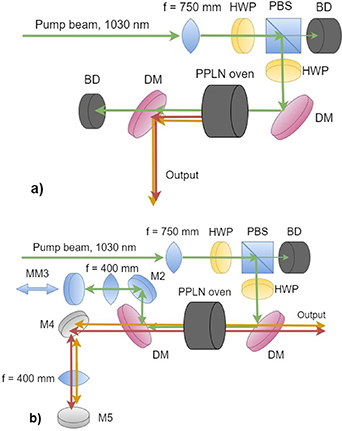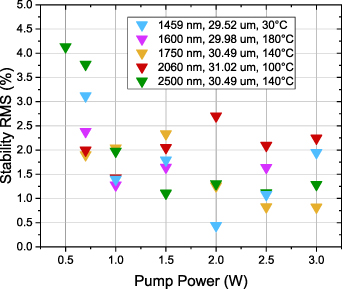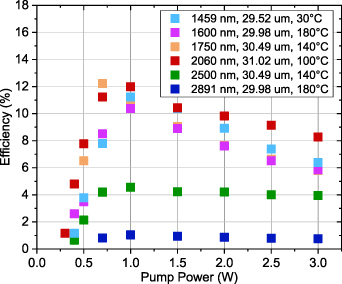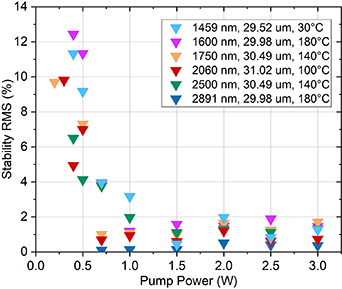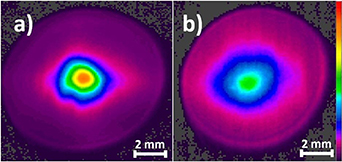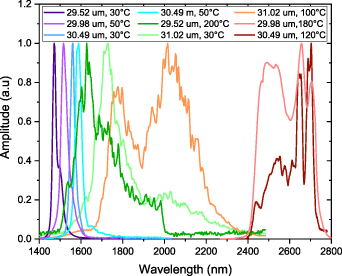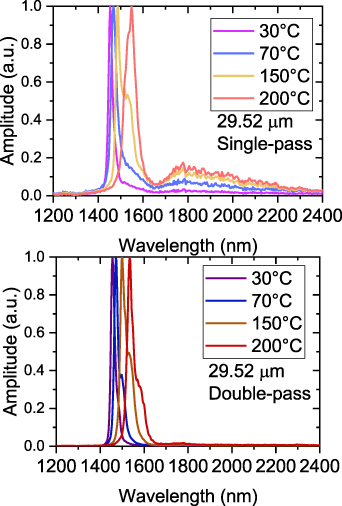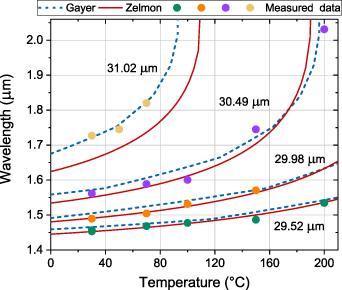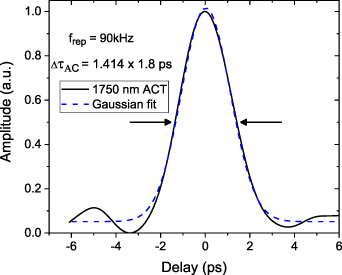Abstract
Many different fields benefit from the usage of light sources emitting in the mid-infrared wavelength range (2–10 µm). A rising need for precise and fast sources in the mid infrared (mid-IR) is reflected in the development of a high-power, picosecond mid-IR source capable of generation at high repetition rates. In this work, we present the optimization of an optical parametric generator, pumped by a 3 W portion of total power of the Yb:YAG thin-disk laser (1.3 ps, 90 kHz, 90 W) by comparing a single-pass and double-pass arrangement output parameters in terms of output power dependences on input power, efficiency, beam profiles, stability, and spectra. The output tunability of both arrangements spanned from 1459 nm to 2891 nm, with the upper limit being influenced by the limited transmission of the dichroic components used in the setup above 2700 nm. It was shown that the double-pass arrangement increases the output power, from 17 mW in the single-pass arrangement to 193 mW in the double-pass arrangement at 1459 nm, resulting in over ten-fold output power increase.
Export citation and abstract BibTeX RIS

Original content from this work may be used under the terms of the Creative Commons Attribution 4.0 license. Any further distribution of this work must maintain attribution to the author(s) and the title of the work, journal citation and DOI.
1. Introduction
Laser technology is one of the most progressive fields of science with wide practical applications spreading from everyday life to modern day industry. From the invention of the laser in 1960 [1] and immediate incorporation of laser light to other fields, such as medicine, a never-ending search for sources capable of generating light at new wavelengths, pulse lengths and repetition rates begun. Particularly interesting is the region of wavelengths from 2–10 µm [2], the so-called mid infrared (mid-IR), due to several interesting phenomena, such as the 'atmospheric window', and the molecular fingerprint region which enable the use of mid-IR sources in environmental, healthcare, and defense sensing applications. The maximum absorption peak of water around 3 µm must not be omitted due to its significant impact on the role of lasers in various fields of medicine, such as ophthalmology, dermatology, urology, and others. The farther end of the mid-IR region is most useful in industry, due to absorption in various polymers and therefore is the wavelength region of choice for applications such as welding, cutting, drilling, and micromachining of plastics [3].
The interaction of ultrashort pulses with matter exhibits unique and useful characteristics, such as mitigation of heat diffusion effects, due to the pulse being shorter than the thermal relaxation of the material and therefore enables fast material removal without significant heating. Additionally, the processing speed and signal-to-noise ratio may be increased by utilizing lasers with high average power and high repetition rate of ultrashort pulses.
In this paper we present a picosecond optical parametric generator (OPG) based on a periodically poled lithium niobate (PPLN) crystal pumped by an in-house developed Yb:YAG thin-disk laser, with emphasis on improvement of various characteristics of output radiation with a double-pass arrangement. Such a system is developed with an aim to serve as a seeding source in a planned mid-IR optical parametric amplifier (OPA), to reach high average power of above 10 W and high repetition rate of 90 kHz in the picosecond regime in the 1.4–3.5 µm range.
2. The pump laser
The pumping is provided by an in-house developed 1030 nm Yb:YAG thin-disk chirped pulse amplification (CPA) laser system operating at 90 W output power at 90 kHz with a pulse duration of 1.3 ps [4] and beam quality of M2 ∼1.2.
The pump pulse autocorrelation trace (ACT) and Gaussian fit can be seen in figure 1, the output spectrum can be seen in figure 2 and the beam profile is shown in the figure 2 inset.
Figure 1. Autocorrelation trace (ACT) of the pump pulses.
Download figure:
Standard image High-resolution imageFigure 2. Spectrum of the pump laser and its beam profile, shown in the inset of the figure
Download figure:
Standard image High-resolution image3. OPG
As presented in the Introduction, many applications in the mid-IR require a broadband, tunable, ultrafast source capable of operating at high average powers and high repetition rates.
The OPG presents a simple, usually single-pass device, and when introduced in periodically poled crystals, such as PPLN, a broadly tunable source can be designed, when combined with temperature tuning. The quasi-phase matching taking place in such crystals utilizes the same polarization state for all interacting wavelengths, thus all beams propagate along crystal axis, leading to zero spatial walk-off. Long crystals can then be employed to improve the efficiency, with maximum length limited by the group velocity mismatch (GVM) of the interacting beams. PPLN is a popular material of choice for the OPG, as it possesses a high effective nonlinear coefficient deff of 14 pm V−1, according to the SNLO software, high laser-induced damage threshold and is commercially available with large apertures up to several centimeters.
Other sources can be employed besides the OPG, such as synchronously pumped optical parametric oscillators (OPO), but these are significantly harder to align and their cavity lengths need to be precisely matched with the repetition rate of the ultrashort pump pulses, which in our case would yield a cavity several kilometers long.
In the picosecond regime with repetition rate of 90 kHz, the OPG-OPA scheme is widely recognized [5]. In this paper, we present a double-pass OPG arrangement, which will serve as a seed source for such an OPA. Other works exploring the PPLN OPG as a mid-IR source were published for MHz pumping in the ns pulse duration region [6] and under MHz picosecond pumping a self-seeding PPLN OPG was also presented [7]. Another source discussing the double-pass arrangement of a Magnesium-oxide (MgO):PPLN OPG under pumping at wavelength of 1.025 µm at 20 kHz is presented in [8], resulting in a signal tunable from 1.3–1.8 µm and idler tunable from 2.5–4.1 µm. The reported optical efficiency for the double-pass arrangement was 8%. In [9], a superluminiscent diode seeded MgO: PPLN OPG is presented under 4 kHz pumping by 700 ps long pulses generated by a Nd:YAG laser. Broadband tunability was shown, spanning the region from 1560 to 3346 nm with 20 nJ energy of tunable signal. It was also shown, that seeding improved the efficiency and reduced the linewidth of the OPG generated beams [9].
In the course of this work, a comparison between the single-pass and double-pass OPG arrangement is presented in terms of output power, spectra, and beam profile. As to the best of our knowledge, no such detailed comparison has yet been published. Additionally, a further characterization of the double-pass arrangement in terms of output pulse length is presented. The schematics of both arrangements are presented in figure 3.
Figure 3. OPG schematics. (a) Single-pass OPG, (b) Double-pass OPG. HWP—half wave-plate, PBS—polarizing beam splitter, BD—beam dump, DM—dichroic mirror (HR@1030 nm, HT@ 1400–2700 nm), M2—highly reflective mirror for 1030 nm, MM3—highly reflective mirror for 1030 nm on a linear motorized translation, M4 and M5—silver-coated mirrors for OPG radiation.
Download figure:
Standard image High-resolution imageThe OPG consists of a single PPLN crystal MOPO1-1.0–10 produced by Covesion Ltd MgO doping is added to prevent photorefractive damage and photodarkening effects thus allowing the usage of higher pumping intensities. The length of the crystal is limited by the temporal walk-off between the pump and the generated signal and idler pulses. If the length of the crystal were to exceed the pulse-splitting length, the interacting pulses would no longer sufficiently temporally overlap, and the efficiency of the nonlinear interaction would decrease accordingly. In our case, the shortest pulse splitting length was calculated to be 11 mm for the signal wavelength of 1750 nm. Therefore, a 10 mm long PPLN crystal was chosen. To increase the maximum useful crystal length, the double-pass arrangement, where the temporal walk-off after the first pass is compensated, is also presented. The commercially available crystal is anti-reflection (AR) coated for the pump (R ∼1.5% at 1030 nm), signal (R ∼0.5%–2% at 1400–1800 nm, R ∼2%–3.5% at 1800–2060 nm) and idler (R ∼3.5%–3% at 2060–2600 nm, R ∼3%1.5% at 2600–3600 nm). In our case, four different periods of poling (29.52, 29.98, 30.49, 31.02 µm), each with a 1 × 1 mm aperture, were used together with temperature tuning to achieve broad wavelength tunability.
The pumping level is adjusted by an attenuator consisting of a half-wave plate and a polarizing beam splitter cube. The f = 750 mm focusing lens is used to focus the beam at the center of the PPLN crystal. Here, the second moment beam diameter was approximately 0.7 mm, measured by an Ophir Spiricon SP620U beam profiler. The pump power was limited to 3 W to ensure a maximum pumping intensity of 15 GW cm−2. This was determined to be a safe value with no damage to the crystal.
The following half-wave plate rotates the polarization beam to the horizontal direction, ensuring an eee Type 0 nonlinear interaction, which yields a deff value of the interaction of 14 pm V−1 as calculated using the SNLO software [10]. The following dichroic mirror serves as a separator of the pump beam and the generated radiation. It is highly reflective (R > 98%) at 1030 nm and highly transmissive in the 1.48–2.8 µm region (T > 80%). The PPLN crystal is placed in an oven with a driver for temperature adjustment from room temperature to 200 °C with a 0.01 °C step. However, as maximal value of pumping at 3 W was found to heat up the crystal to 27 °C, the minimum oven temperature was set to 30 °C to mitigate temperature fluctuations due to heat generation. The second pass arrangement (figure 3(b)) includes the separation of the pump and generated radiation into two branches by another piece of the same dichroic mirror used at the input and output of the OPG. The pumping radiation is reflected upon a dielectric mirror MM3 located on a motorized linear translation stage used to adjust the temporal overlap of the pumping and OPG pulses in the crystal upon the second pass. The f = 400 mm lens is used to preserve high intensity of the pumping of the crystal upon the second pass. The diameter of the pump beam in the crystal is the same as in the case of the first pass, approximately 0.7 mm. The same focal length lens with appropriate coating is used in the signal/idler self-seeding branch of the second pass, with a fixed Ag coated mirror at the end of the branch. Both end mirrors of the two branches are in kinematic mounts which allow optimization of beam overlap upon second pass through the PPLN crystal for maximum efficiency.
As previously mentioned, the OPG stage consisting of four poling periods allows for broad wavelength tunability when paired with a temperature-controlled oven. The calculated tunability curves can be seen in figure 4. For each period the spectral width of the generated signal or idler radiation is expected to increase with temperature because the curves become increasingly steep. At the so-called degeneracy point at 2060 nm, where the signal and idler beams are identical, the broadest spectrum is expected. As can also be seen in figure 4, tunability curves calculated from Sellmeier equations from different [11, 12] do not coincide, with maximum difference of 16 °C at the 2060 nm degeneracy point for the 31.02 µm poling period. In our case, the minimal achievable wavelength is 1459 nm at 30 °C and 29.52 µm poling period, as will be shown later in the text.
Figure 4. Calculated temperature wavelength tunability curves for different periods of the PPLN crystal derived from Sellmeier equations published by Gayer and Zelmon in [11] and [12], respectively.
Download figure:
Standard image High-resolution image3.1. Single-pass OPG
For the single-pass OPG the output power of the generated signal and idler beams was measured by an Ophir 3A detector after one pass of pumping through the PPLN crystal. In figure 5 the output power dependence of the signal and idler beams on the input power is shown. The dependences are approximately linear, however wavelengths 1459 nm, 1600 nm and 1750 nm exhibit saturation behavior over approximately 1.5 W pumping. The highest output power of 100 mW is reached at the maximal 3 W level of pumping at 2060 nm degeneracy point The maximal output power for other wavelengths decreases with decreasing wavelength, from 55 mW at 2500 nm down to 17 mW at 1459 nm. The threshold pump power is the lowest for the 2060 nm beam at 0.5 W and rises to 0.7 W pumping power for all other measured wavelengths.
Figure 5. Output power dependence of signal and idler beams on pump power for single-pass OPG.
Download figure:
Standard image High-resolution imageIn terms of efficiency, the highest value of 3.6% is reached for 2.5 W pumping power at 2060 nm. Conversion efficiency is seen to exhibit saturation for all wavelengths, as can be seen in figure 6. The efficiency of the generation is limited by the crystal aperture as well as the damage threshold of the PPLN crystal.
Figure 6. OPG conversion efficiency dependence on pump power for single-pass OPG.
Download figure:
Standard image High-resolution imageThe stability of the average output power over a period of 30 s was also measured. The pump beam average power stability was measured to be 0.5% RMS root mean square (RMS) over 10 min. As can be seen in figure 7 the RMS values of the single-pass OPG mostly decrease with increasing pump power, as efficiency exhibits saturation. At the maximum pump power, the power stability of the OPG ranges from 0.7% to 2.2%, depending on the measured wavelength. Fluctuations of the generated power are therefore higher than pump fluctuations, as can be expected from the quantum noise amplification character of the OPG.
Figure 7. Dependence of power stability (RMS) of the signal and idler beams of single-pass OPG on pump power.
Download figure:
Standard image High-resolution imageIn the following figures figures 8(a) and (b) the beam profiles for signal and idler at 1600 nm and 2891 nm, respectively, can be seen. The profiles were measured by an Ophir Spiricon Pyrocam III beam profiler. A focusing lens with f = 100 mm was placed at the output of the single-pass OPG (figure 3) to increase the intensity of the beams to a level detectable by the beam profiler, which was placed 210 mm behind the focusing lens due to the high divergence of the OPG beam. Due to this fact, the outline of the 1-inch lens is visible in the beam profiles, which also possess a significant pedestal. This may be attributed to noncollinear three-wave interaction also taking place in the PPLN crystal. Due to low focusability the single-pass arrangement is not an optimal option for seeding a parametric amplifier in the mid-IR range.
Figure 8. Beam profiles of single-pass OPG radiation at 1600 nm (a) and 2891 nm (b).
Download figure:
Standard image High-resolution imageThe output spectra were measured by an Optosky ATP8000 fiber spectrometer and are presented in figure 9. The presented spectra were not corrected for the spectral response of the spectrometer. The tunability spans the range from 1459 nm to approximately 2400 nm, which coincides with the detection limit of the spectrometer. Due to the low spectral density, idler beams beyond 2400 nm were undetectable by another spectrometer Andor Solis Shamrock 303i with a pyroelectric line array detector PY-LA-S-510, which was used later in the characterization of the double-pass arrangement. It can be seen in figure 9 that with central wavelength approaching degeneracy, the bandwidth of the spectra increases. The spectral full width at half maximum ranges from 26 nm at 29.52 µm, 30 °C (central wavelength 1459 nm) to 412 nm at 31.02 µm, 50 °C (central wavelength 2000 nm). This is in accordance with the tunability curves presented in figure 4.
Figure 9. Spectral tunability of the single-pass OPG.
Download figure:
Standard image High-resolution image3.2. Double-pass OPG
The output power of the double-pass OPG was measured with the Ophir 3A detector. Its dependance on pump power is presented in figure 10. Maximum output power of 250 mW was generated at the degeneracy point at 2060 nm at 3 W pumping with 8% conversion efficiency. With increasing wavelength, maximal reached output power decreases, with 2891 nm idler being the least powerful. All signal beams at 1459 m, 1600 nm, 1750 nm and at the degeneracy point of 2060 nm show clear flattening of the power dependance curve, suggesting the saturation phenomenon, which can be attributed to the parasitic effects such as back-conversion, second and higher harmonic generation and sum frequency generation [9]. Figure 11 depicts the increase in power after the second pass as compared to the first pass at maximum pumping of 3 W. Added to the figure is also the transmission curve of the dichroic mirror, which was measured by a Shimadzu UV-3600 spectrophotometer. The sharp decline in power above 2700 nm can be explained by the influence of the DM. Whereas the maximum efficiency reached in the single-pass by the 2060 nm beam was around 3.5%, for the double-pass it was 12%, as is presented in figure 12. The efficiency is therefore improved over three-fold as compared to the single-pass arrangement. Such increase in conversion efficiency in the double-pass is in fact observed for all wavelengths in the whole range of used pump power. The threshold values also decrease from above 0.5 W for the single-pass to around 260 mW for the double-pass at 2060 nm. Maximum efficiency for all wavelengths except 1750 nm was at 1 W pumping. For 1750 nm the maximum efficiency was reached at 0.75 W pumping, slightly above 12%.
Figure 10. Output power dependence of signal and idler beams on pump power for double-pass OPG.
Download figure:
Standard image High-resolution imageFigure 11. Comparison of output power of single-pass and double-pass OPG dependence on wavelength for pumping power 3 W. Drop in DM transmission at 1750 nm is due to a change in detectors during the measurement process in the Shimadzu UV-3600 spectrophotometer.
Download figure:
Standard image High-resolution imageFigure 12. OPG efficiency dependence of signal and idler beams on pump power for double-pass OPG.
Download figure:
Standard image High-resolution imageThe double-pass arrangement thus proves to be an easy and efficient solution for the OPG power-scaling, while being a simple modification of the single-pass with only an addition of two fixed mirrors, a delay line and two focusing lenses.
In figure 13 the double-pass OPG average power stability results can be seen. For the double-pass OPG, all wavelengths reach stability below 2% RMS above 1.5 W pumping, which can be attributed to the saturation phenomenon, while for the single-pass beams, even at 3 W pumping, the stability values exceed the 2% value. The double-pass arrangement thus demonstrates improved average power stability as compared to the single-pass OPG at the same pumping power.
Figure 13. RMS value of single-pass OPG output dependence on pump power.
Download figure:
Standard image High-resolution imageTo capture the beam profiles of the double-pass OPG by the Spiricon Pyrocam III beam profiler, a f = 100 mm lens was placed immediately behind the output DM mirror (see figure 3). The distance of the profiler from the lens was the same as in the single-pass arrangement, 210 mm. Measured beam profiles for double-pass signal at 1600 nm and double-pass idler at 2891 nm can be seen in figures 14(a) and (b), respectively. By comparison with beam profiles obtained in the single-pass arrangement (figure 8), it can be concluded that the double-pass arrangement reduces the beam divergence and improves the beam structure as the double-pass beam profiles can be considered more Gaussian-like.
Figure 14. Beam profiles of double-pass OPG radiation at 1600 nm (a) and 2891 nm (b).
Download figure:
Standard image High-resolution imageIn figure 15 the spectral tunability of the double-pass arrangement is presented. The tunability ranges from 1459 nm to 2750 nm. The spectrometer used for the range of 1400–2600 nm was Optosky ATP8000, and above 2600 nm Andor Solis Shamrock 303i with a pyroelectric line array detector PY-LA-S-510 was used. Unfortunately, beams above 2750 nm could not be measured due to their low power, which was a result of the low optical transmission of the used dichroic mirrors beyond 2700 nm.
Figure 15. Wavelength tunability of the double-pass OPG.
Download figure:
Standard image High-resolution imageBy comparing the spectra at 29.52 µm in the single-pass and double-pass arrangement in figure 16, it can be concluded that the double-pass arrangement significantly decreases the spectral linewidth by decreasing the amplitude of the second spectral peak, which is present in the single-pass arrangement. Thereby, the spectral energy density is increased as compared to the single-pass. Similar behavior between seeded and unseeded lithium niobate (LNBO) generator/amplifier spectra were reported in [13].
Figure 16. Spectra comparison of single-pass (top) and double-pass (bottom) OPG signal beams.
Download figure:
Standard image High-resolution imageIt was also observed that the peak wavelengths of the single-pass and double-pass arrangement experience a certain shift (up to 50 nm in central wavelength per mm at 2060 nm degeneracy point), as was also reported in [9]. However, we found that after precise angular alignment of the second pass pump and seed beams the spatial chirp was removed and all parts of the beam were found to exhibit same spectral characteristics. In figure 17 the calculated temperature wavelength tunability curves previously presented in figure 4 are shown to overlap very well with the measured central wavelengths of the signal beams.
Figure 17. Measured second-pass central wavelengths of signal beams (points) vs. theoretical temperature tunability curves (lines) for the PPLN crystal.
Download figure:
Standard image High-resolution imageFor the double-pass arrangement, autocorrelation traces were measured by the APE PulseCheck 50 autocorrelator with appropriate crystal modules and a photomultiplier detector supplied with the autocorrelator. The autocorrelation traces for 1750 nm signal and 2500 nm idler beams are presented in figures 18 and 19, respectively. The pulse widths were determined by fitting the autocorrelation curve with a Gaussian function and are presented for all measured wavelengths in figure 20 along with simulated pulse lengths and respective GVM.
Figure 18. Autocorrelation trace and Gaussian fit for 1750 nm signal beam of double-pass OPG.
Download figure:
Standard image High-resolution imageFigure 19. Autocorrelation trace and Gaussian fit for 2500 nm idler beam of double-pass OPG.
Download figure:
Standard image High-resolution imageFigure 20. Pulse length dependance on wavelength for double-pass OPG, measured values and SNLO simulation comparison. GVM—group velocity mismatch of pump vs. respective wavelength of the signal or idler pulse.
Download figure:
Standard image High-resolution imageAt 1500 nm the measured pulse length was 1.6 ps. With increasing wavelength, the pulse length exhibited an upward trend, with maximum of 1.8 ps at 1750 nm. With further increasing wavelength, the measured pulse length decreased, with a measured minimum of 1.4 ps at 2891 nm, thus all measured values being larger than the pump pulse length of 1.3 ps. The observed behavior can be largely attributed to the effect of GVM between the pump pulse and the signal/idler pulses, shown here as the green dashed curve. As can be seen, the measured values follow the same trend as the GVM values. The higher the GVM, the faster is the temporal mismatch development between the center of the signal pulse and the center of the pumping pulse. While the center of the signal pulse travels from under the center of the pump pulse, the pump still continuously amplifies the edge of the signal pulse, thus prolonging its duration. Because the GVM value is lower for the idler pulses, they are not prolonged as much as the signal pulses. Additionally, the measured data were also compared with simulated values from the SNLO software. It can be said that the shape of the measured curve overall agrees with the simulation. However, the simulation implies that pulse duration of the generated beams could become even shorter than the pump pulse itself. This is due to the fact, that the gain is nonlinearly dependent on the intensity. The edges of the pulse are amplified less than the central part which can result in the generated pulse being shorter that the pump pulse. The different trend of signal pulse length from 1500 nm to 1750 nm between simulated and measured values can be affected by the accuracy of autocorrelator alignment, uncertainty of the autocorrelation measurement due to its inherent symmetry, and of the simulation parameters. Furthermore, a correlation between pulse length and efficiency saturation can be found by comparing figures 20 and 12. It can be noted that wavelengths 1459 nm, 1600 nm and 1750 nm exhibit the largest decrease of efficiency with increasing pump power and these wavelengths also correspond to the largest measured pulse lengths. On the other hand, the efficiency drop is the smallest for 2891 nm, with increasing trend toward 2060 nm, which is in correspondence with pulse length increase from 2891 nm to 2060 nm in figure 20.
4. Conclusion
In this paper we presented a picosecond OPG based on a PPLN crystal pumped by an in-house developed ytterbium thin-disk laser. Such a system was developed as a seeding source in a planned mid-IR optical parametric amplifier. A single-pass and double-pass OPG comparison was presented in terms of achievable output power, fluence beam profile, efficiency, wavelength tunability and pulse duration was shown. During this work, it was shown that the double-pass arrangement increases the output power, with maximum increase from 17 mW in the single-pass arrangement to 193 mW, resulting in an over ten-fold output power increase. Efficiency of the conversion of 1030 pump radiation to mid-IR radiation was also found to increase in the double-pass arrangement, with maximum at 12% at 2060 nm, as opposed to 3.5% at the same wavelength in the single-pass arrangement. Divergence of the generated beams was also found to decrease in the double-pass arrangement, as was the spectral density of the respective beams. The output wavelength for both arrangements is tunable from 1459 nm to 2891 nm. The upper limit of the tunability range is influenced by the transmission of the dichroic components used in the setup, which exhibit transmission decrease above 2700 nm, thus the theoretical limit of 3503 nm idler corresponding to 1459 nm signal beam would require an optimized dichroic mirror with increased transmission above 2700 nm. Pulse duration was measured for the double-pass arrangement, with values ranging from 1.4 ps at 2891 nm to 1.8 ps at 1750 nm, as compared to the 1.3 ps pump pulse duration. In conclusion, the double-pass arrangement was shown to vastly improve the output characteristics of an OPG arrangement. With only a simple modification of the single-pass arrangement, adding only two mirrors, a motorized translation stage and two lenses, it is possible to significantly reduce the complexity and cost of a broadly tunable, picosecond mid-IR system.
Acknowledgments
This paper was co-financed by the European Regional Development Fund and the state budget of the Czech Republic (project HiLASE CoE: Grant No. CZ.02.1.01/0.0/0.0/15_006/0000674), by the European Union's Horizon 2020 research and innovation programme under Grant agreement Nos. 739573 (HiLASE CoE) and 871124 (Laserlab-Europe), and The Student Grant Competition No. SGS22/184/OHK4/3T/14 at Czech Technical University in Prague.




